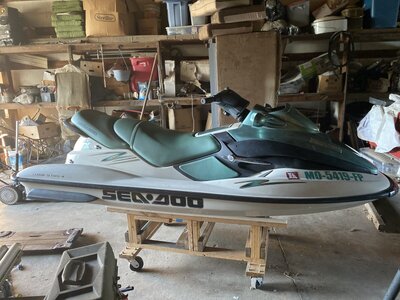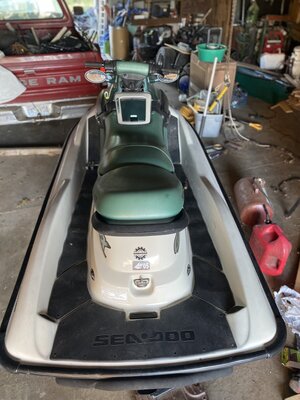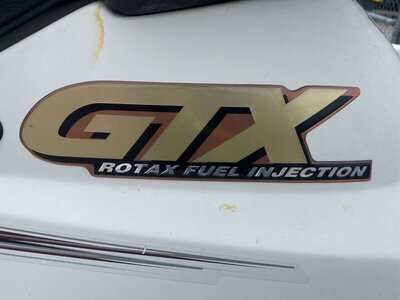Hello guys, I have a 2000 seadoo bomba millenium edition Rotax Fuel injection that starts fine on trailer and will rev fine on trailer but when It’s on the water it starts just fine but will not take off it has no acceleration the rpm stays low as well it’s not revving high it just bogs.i also checked compression and compression is good in both cylinders. Any ideas on what to check and what to be looking is greatly appreciated. I will add videos of it running off water this weekend if weather allows it.
-
This site contains eBay affiliate links for which Sea-Doo Forum may be compensated.
You are using an out of date browser. It may not display this or other websites correctly.
You should upgrade or use an alternative browser.
You should upgrade or use an alternative browser.
Acceleration issue/bogging 2000 GTX RFI
- Thread starter Vader00
- Start date
- Status
- Not open for further replies.
DaddyLoafin
Active Member
just a guess but have you checked to see if the injectors are flowing properly?
What are the compression numbers? Did you replace the spark plugs (one might be surprised and how often this solves problems). Is the battery up to full voltage and in good condition? Are you getting spark to both cylinders? Try these.
View attachment 64705Compression numbers are 130 and 150 yes I changed spark plugs and yes to spark in both cylinders
Haven’t gotten a chance to check this yet but I willjust a guess but have you checked to see if the injectors are flowing properly?
It is a process but you have much to check. Here are a couple more. Is the check valve from the crank case to the rave solenoid functioning. Test the raves with low pressure to make sure they are opening and holding reasonably well. Check fuel pressure. I'd send the fuel injectors out for cleaning. Do all the component checks for the sensors per repair manual. Plug #4. Unplug the rectifier.
As soon as the shops warms up a bit I’ll do everything and I will report back with an update thanks allIt is a process but you have much to check. Here are a couple more. Is the check valve from the crank case to the rave solenoid functioning. Test the raves with low pressure to make sure they are opening and holding reasonably well. Check fuel pressure. I'd send the fuel injectors out for cleaning. Do all the component checks for the sensors per repair manual. Plug #4. Unplug the rectifier.
Grast5150
Member
OK first thing disregard RAVE valve comments as they only apply when throttle is 70% or greater. A rave valve not rising reduces the top RPM of the engine but does not hamper low end as you are describing especially out of water.
Since you have a DI, this add two component which need to be checked. The first is fuel pump pressure. However, this is not as easy as a vehicle as a DI has two pressures. 25 Psi at idle and 118 to 120 at full throttle. In order to test the fuel rail, you will need to either make or buy a test rig. I chose to buy it as did not want to waste time with finding the correct fittings. Here is my suggestion (I make NOTHING on this suggestion. I have just used this product and it worked.): fuel pressure test rig
Once you are able to verify that fuel pressure at idle and at full throttle is up to spec. The next thing to check is the air compressor. I suggest the following rig as well. FYI, Air compressor rig: DI air pressure Tee fitting. Please watch this on how to use:
. This video will allow you to monitor and inject air into the fuel rail. If this air compressor is worn OR there are leaks, this can lead to lower air pressure and result in your behavior. In my experience, the only other situation would be a failure or leakage of air from the Air Injector 275500512. The carbon ring on the air injectors can start to leak air and result in lower air injection but this is long shot.
The final rare situation is the fuel injectors. However in my opinion, these either work or do not. So, this is worst case and last explanation, as such I would rather spend time looking at fuel pressure or air pressure leaks. NOTE: air pressure leaks from RAVE Valves if sever enough could cause this issue. however, I would have expected you to say something about loud air noises. But for clarifications, please verify with soap and water all of the air hoses. See: Sea-Doo 2001 GTX DI 5529 OEM Parts Diagram for Air Intake System | Partzilla.com
With all this said, I would start first at the fuel pump, verify fuel pressure, and then move to air.
Later.
Since you have a DI, this add two component which need to be checked. The first is fuel pump pressure. However, this is not as easy as a vehicle as a DI has two pressures. 25 Psi at idle and 118 to 120 at full throttle. In order to test the fuel rail, you will need to either make or buy a test rig. I chose to buy it as did not want to waste time with finding the correct fittings. Here is my suggestion (I make NOTHING on this suggestion. I have just used this product and it worked.): fuel pressure test rig
Once you are able to verify that fuel pressure at idle and at full throttle is up to spec. The next thing to check is the air compressor. I suggest the following rig as well. FYI, Air compressor rig: DI air pressure Tee fitting. Please watch this on how to use:
The final rare situation is the fuel injectors. However in my opinion, these either work or do not. So, this is worst case and last explanation, as such I would rather spend time looking at fuel pressure or air pressure leaks. NOTE: air pressure leaks from RAVE Valves if sever enough could cause this issue. however, I would have expected you to say something about loud air noises. But for clarifications, please verify with soap and water all of the air hoses. See: Sea-Doo 2001 GTX DI 5529 OEM Parts Diagram for Air Intake System | Partzilla.com
With all this said, I would start first at the fuel pump, verify fuel pressure, and then move to air.
Later.
Pretty sure it’s an RFIOK first thing disregard RAVE valve comments as they only apply when throttle is 70% or greater. A rave valve not rising reduces the top RPM of the engine but does not hamper low end as you are describing especially out of water.
Since you have a DI, this add two component which need to be checked. The first is fuel pump pressure. However, this is not as easy as a vehicle as a DI has two pressures. 25 Psi at idle and 118 to 120 at full throttle. In order to test the fuel rail, you will need to either make or buy a test rig. I chose to buy it as did not want to waste time with finding the correct fittings. Here is my suggestion (I make NOTHING on this suggestion. I have just used this product and it worked.): fuel pressure test rig
Once you are able to verify that fuel pressure at idle and at full throttle is up to spec. The next thing to check is the air compressor. I suggest the following rig as well. FYI, Air compressor rig: DI air pressure Tee fitting. Please watch this on how to use:. This video will allow you to monitor and inject air into the fuel rail. If this air compressor is worn OR there are leaks, this can lead to lower air pressure and result in your behavior. In my experience, the only other situation would be a failure or leakage of air from the Air Injector 275500512. The carbon ring on the air injectors can start to leak air and result in lower air injection but this is long shot.
The final rare situation is the fuel injectors. However in my opinion, these either work or do not. So, this is worst case and last explanation, as such I would rather spend time looking at fuel pressure or air pressure leaks. NOTE: air pressure leaks from RAVE Valves if sever enough could cause this issue. however, I would have expected you to say something about loud air noises. But for clarifications, please verify with soap and water all of the air hoses. See: Sea-Doo 2001 GTX DI 5529 OEM Parts Diagram for Air Intake System | Partzilla.com
With all this said, I would start first at the fuel pump, verify fuel pressure, and then move to air.
Later.
Grast5150
Member
All of the 2000-2002 Sea-Doo GTX 951 Millennium (Rotax 947) are 951 engines. I did find the product numbers showing both carb and DI versions. Since he did not specify carb model or show pictures. I am assuming the 915 DI engine.Pretty sure it’s an RFI
There’s RFI’s, DI’s and carbed Pretty sure this is a 787 RFIAll of the 2000-2002 Sea-Doo GTX 951 Millennium (Rotax 947) are 951 engines. I did find the product numbers showing both carb and DI versions. Since he did not specify carb model or show pictures. I am assuming the 915 DI engine.
Grast5150
Member
He says very specifically Millennium Edition. the 2000-2002 Sea-Doo GTX 951 Millennium are 947 engines. If you he had stated 2000 Sea-doo RFI, you would be correct. That is a 787. But the title is "2000 seadoo bomba millenium edition Rotax Fuel injection" which means 947 DI.There’s RFI’s, DI’s and carbed Pretty sure this is a 787 RFI
My mistake thenHe says very specifically Millennium Edition. the 2000-2002 Sea-Doo GTX 951 Millennium are 947 engines. If you he had stated 2000 Sea-doo RFI, you would be correct. That is a 787. But the title is "2000 seadoo bomba millenium edition Rotax Fuel injection" which means 947 DI.
Grast5150
Member
No worries, thank you for the comment as I had forgotten the RFI version for that year was a 787. Later.My mistake then
No, that is wrong.He says very specifically Millennium Edition. the 2000-2002 Sea-Doo GTX 951 Millennium are 947 engines. If you he had stated 2000 Sea-doo RFI, you would be correct. That is a 787. But the title is "2000 seadoo bomba millenium edition Rotax Fuel injection" which means 947 DI.
Rotax Fuel Injection is a RFI ski and is what the OP posted in his picture. RFI is not Direct Injection, it is a fuel injected 787.
If it was a DI the GTX sticker below the seat would say Direct Fuel Injection, DI which this particular ski is not.
Thank you for all this information I’m definitely going to follow this advice. Ps for everyone wondering it’s a 951cc engine pretty sure it’s fuel injected. I know nothing though so take what I say with a grain of salt I know the engine is 951cc though for sure.OK first thing disregard RAVE valve comments as they only apply when throttle is 70% or greater. A rave valve not rising reduces the top RPM of the engine but does not hamper low end as you are describing especially out of water.
Since you have a DI, this add two component which need to be checked. The first is fuel pump pressure. However, this is not as easy as a vehicle as a DI has two pressures. 25 Psi at idle and 118 to 120 at full throttle. In order to test the fuel rail, you will need to either make or buy a test rig. I chose to buy it as did not want to waste time with finding the correct fittings. Here is my suggestion (I make NOTHING on this suggestion. I have just used this product and it worked.): fuel pressure test rig
Once you are able to verify that fuel pressure at idle and at full throttle is up to spec. The next thing to check is the air compressor. I suggest the following rig as well. FYI, Air compressor rig: DI air pressure Tee fitting. Please watch this on how to use:. This video will allow you to monitor and inject air into the fuel rail. If this air compressor is worn OR there are leaks, this can lead to lower air pressure and result in your behavior. In my experience, the only other situation would be a failure or leakage of air from the Air Injector 275500512. The carbon ring on the air injectors can start to leak air and result in lower air injection but this is long shot.
The final rare situation is the fuel injectors. However in my opinion, these either work or do not. So, this is worst case and last explanation, as such I would rather spend time looking at fuel pressure or air pressure leaks. NOTE: air pressure leaks from RAVE Valves if sever enough could cause this issue. however, I would have expected you to say something about loud air noises. But for clarifications, please verify with soap and water all of the air hoses. See: Sea-Doo 2001 GTX DI 5529 OEM Parts Diagram for Air Intake System | Partzilla.com
With all this said, I would start first at the fuel pump, verify fuel pressure, and then move to air.
Later.
I think you should post a picture of the engine. It does say RFI on the machine and there are no 951 RFI’s to my knowledge anyways.Thank you for all this information I’m definitely going to follow this advice. Ps for everyone wondering it’s a 951cc engine pretty sure it’s fuel injected. I know nothing though so take what I say with a grain of salt I know the engine is 951cc though for sure.
Haven’t checked anything since out in shop for winter yet. Winter storm hit and has been too cold to go in shop. I appreciated all the information and will post updates when I get a chanceThank you for all this information I’m definitely going to follow this advice. Ps for everyone wondering it’s a 951cc engine pretty sure it’s fuel injected. I know nothing though so take what I say with a grain of salt I know the engine is 951cc though for sure.
I think you should post a picture of the engine. It does say RFI on the machine and there are no 951 RFI’s to my knowledge anyways
okay I will also post a picture of the engine I thought I had one laying around on my phone but I don’t. I’ll be sure to take a picture. Im not 100 percent sure. I will get some work done on it FridayI think you should post a picture of the engine. It does say RFI on the machine and there are no 951 RFI’s to my knowledge anyways.
Last edited:
I sometimes find a picture I want in my text message large attachments when I’m trying to free up some storage on my phoneOkay I’ll post a picture of the engine
okay I will also post a picture of the engine I thought I had one laying around on my phone but I don’t. I’ll be sure to take a picture. Im not 100 percent sure
If the picture in your first post is of the ski that you are working on then it is a GTX RFI 787 and not a 951DI.Thank you for all this information I’m definitely going to follow this advice. Ps for everyone wondering it’s a 951cc engine pretty sure it’s fuel injected. I know nothing though so take what I say with a grain of salt I know the engine is 951cc though for sure.
There are two of the identical skis across the street from my driveway and I have personally worked on both of them.
If your seat decal says this.....
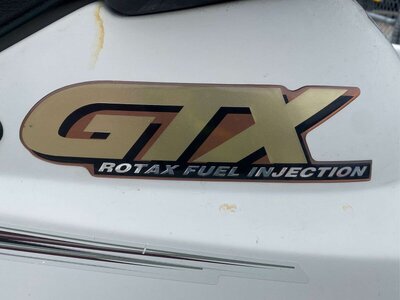
It is a RFI 787 RFI is literally Rotax Fuel Injection.
If it says GTX Rotax Direct Fuel Injection under the seat like this....
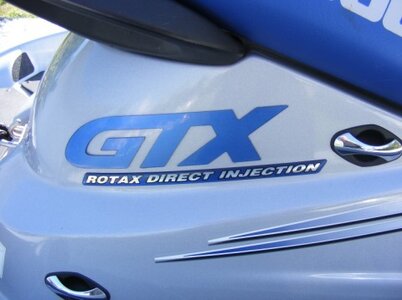
It is a 951/947 Direct Injection.
Also the DI skis did not come in your colors above, it would have been Viper red or Mazatlan Blue in the 2000-2001 ish years.
BTW: Yours is a 787 RFI.
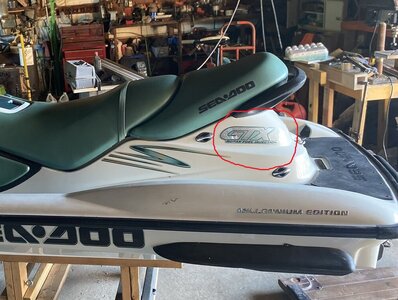
Engines...
787 RFI
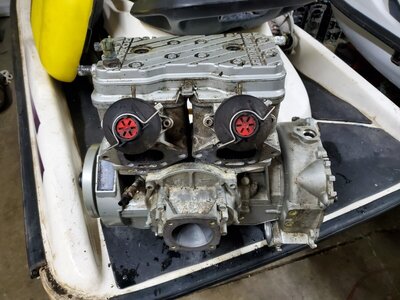
951 DI
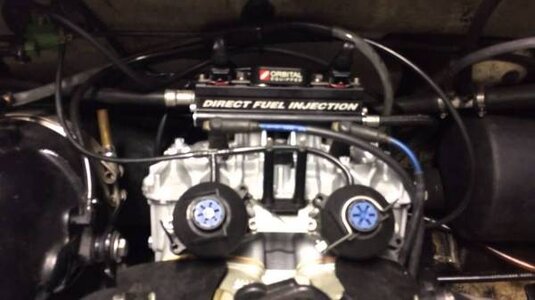
Attachments
Last edited:
If compression checks out good and it starts and runs I would try replacing the fuel filters first on a ski with your symptoms.
This thread has the procedure and part numbers... The RFI (Rotax Fuel Injection ) Spot
This thread has the procedure and part numbers... The RFI (Rotax Fuel Injection ) Spot
Last edited:
Yes the engine is the exact same as the one you said it was. Thank you for your knowledge didn’t even have to look under the seat.If the picture in your first post is of the ski that you are working on then it is a GTX RFI 787 and not a 951DI.
There are two of the identical skis across the street from my driveway and I have personally worked on both of them.
If your seat decal says this.....
View attachment 64735
It is a RFI 787 RFI is literally Rotax Fuel Injection.
If it says GTX Rotax Direct Fuel Injection under the seat like this....
View attachment 64736
It is a 951/947 Direct Injection.
Also the DI skis did not come in your colors above, it would have been Viper red or Mazatlan Blue in the 2000-2001 ish years.
BTW: Yours is a 787 RFI.
View attachment 64737
Engines...
787 RFI
View attachment 64739
951 DI
View attachment 64740
LOL, no problem. I have been here a while, probably too long.Yes the engine is the exact same as the one you said it was. Thank you for your knowledge didn’t even have to look under the seat.
Grast5150
Member
I stand corrected by mikidymac. He is correct. Plus the pictures you put up are a 787 engine and not a 951. so please disregard my post as those directions do not apply.Thank you for all this information I’m definitely going to follow this advice. Ps for everyone wondering it’s a 951cc engine pretty sure it’s fuel injected. I know nothing though so take what I say with a grain of salt I know the engine is 951cc though for sure.
- Status
- Not open for further replies.
Similar threads
- Replies
- 42
- Views
- 2,697
- Replies
- 6
- Views
- 467
- Replies
- 10
- Views
- 708
- Replies
- 9
- Views
- 807




